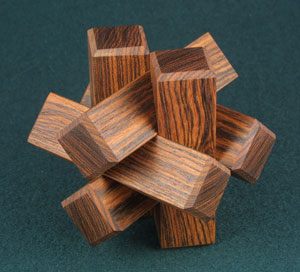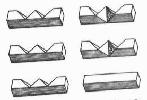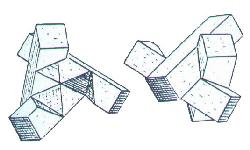
Larger Photograph (102.8K)


| Designer | : | Ford | ||
| Craftsman | : | Tom Lensch | ||
| Category | : | Interlocking | ||
| Material | : | Bocote | ||
| Pieces | : | 6 | ||
|
The origin of the Diagonal Burr is unknown. There is a patent to Chandler in 1888, but it is a complicated version with a sliding key. A patent to Ford in 1905 is for the symmetrical version, but is describes a complicated assembly instead of the simple mating of two halves containing three pieces each. The first versions had three pieces with two v-shaped notches, two with three notches and a key with no notches. They are shown at
If you play around with this type of Diagonal Burr, you will find that the "key" piece is not really a key. It need not go in last or come out first. Diagonal burrs of this style can be made with lots of pieces. Although it produces a massive burr that will impress your friends, it is ultimately boring. The assembly using six identical pieces (the two-notch type) is far more interesting and makes the Diagonal Burr into the "mother" of a tremendous variety of beautiful and interesting offspring, most of which give no clue to their origin with their external appearance. It is assembled by mating two mirror-image sub-assembies (shown at the left) together. This same technique is used for all of the variations. The first variation of the Diagonal Burr occurs when the ends of the pieces are beveled at a 45° angle. The resulting puzzle is called the Diagonal Star, or simply Star. The Diagonal Star is the first stellation of the rhombic dodecahedron.
| ||||
